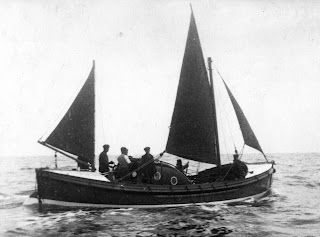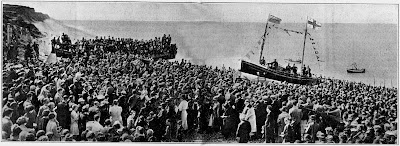On being demobbed in 1946 and returning to Sheringham, one of my first actions was to enrol in the crew list of the town’s lifeboat station that was run by the Royal National Lifeboat Institution (RNLI).
The lifeboat that I trained on, and crewed for the next fifteen years was the "Foresters Centenary". She was paid for by the Ancient Order of Foresters to commemorate their centenary in 1934.
 |
| Emblem of the Ancient Order of Foresters |
The Foresters, as they were known in Sheringham, was a Friendly Society and had funded previous lifeboats for the RNLI. When they heard that the last of their previous lifeboats was being withdrawn from service, they set up an appeal to raise £3,500 for a Liverpool class motor lifeboat.
The RNLI decided, with the approval of the Foresters, to place her at Sheringham.
 |
| Foresters Centenary on Trials at the Isle of Wight |
"Foresters Centenary" was one a new generation of lifeboats with a petrol engine as well as sails. She was built by Groves and Guttridge on the Isle of Wight and measured 35 feet 6 inches long, and 10 feet 3 inches beam.
The hull was composed of the traditional two counter-diagonal layers of Honduras mahogany separated by a tight sheet of calico coated with white lead.
Within the hull there were six water-tight compartments filled with 115 air cases. Water on deck would drain through scupper plates on either side of the hull. Not only was the engine room a water-tight compartment, but even the engine itself was water-tight.
 |
| Details of "Foresters Centenary" Design |
The 35 horse power AE6 petrol motor had been designed by the RNLI, and built by the engineering firm of Weyburn.
 |
| AE6 Petrol Engine |
Full speed was 7 ⅓ knots and the range was 100 miles at full speed. Thirty survivors could be carried, as well as the normal crew of seven.
"Foresters Centenary" arrived at Sheringham in June 1936 and replaced the pulling and sailing lifeboat "J.C. Madge", in the boathouse at Old Hythe. I remember that naming ceremony in July as we had a day off school. Train loads of ‘Foresters’ arrived in town and then marched to Old Hythe with brass bands playing.
 |
| Naming Ceremony of Foresters Centenary |
The whole town was proud of its new motor lifeboat and lined the cliff tops after the naming ceremony.
 |
| Foresters Centenary after her Naming Ceremony |
A few months later, "Foresters Centenary" was moved to a new lifeboat house at the end of the promenade at Sheringham, however, in 1936, little did anyone know what lay in store over the following decade.
Within three years Foresters Centenary was on the front line and her record in World War II was:
Launches on Service: 59
Stood by for Service: 20
Lives Saved: 42
Indeed, the records in the ‘Lifeboat Journal’ confirmed that the old crew were correct.
 |
| Airmen's Lives Saved by RNLI Lifeboats during WW2 (Lifeboat Journal 1939-46, RNLI) |
That’s not the whole story though, as airmen’s lives were also saved at Sheringham by fishermen in their crab boats. Also, the "Foresters Centenary" was regularly lowered down the slipway so that returning airmen could see that help was at hand if they needed it. As a result, "Foresters Centenary" became known as ‘The Airmen’s Lifeboat'.
Unfortunately, Henry had passed away by the time a magazine article on this subject was published in 2009.
 |
| “Best of British” magazine, May 2009, p.38 |
My war-time experience in the Royal Naval Patrol Service was counted as equivalent to an apprenticeship in the local fishing industry. Nevertheless, I had a great amount to learn about lifeboat work, and this was happened on practice launches and in the lifeboat house on Sunday mornings.
The older crew members who taught me were those that had manned the pulling and sailing lifeboats "J.C.Madge" and "Henry Ramey Upcher", as well as the "Foresters Centenary". Some of these old characters can be seen on board "Foresters Centenary" after rescuing five Polish airmen on 28th October 1941.
 L-R: Harry (Monchy) Middleton, Henry (Downtide) West, Bennet Middleton, Billy (Cutty) Craske, Cox’n Jimmy Dumble, 2nd Cox’n John (Sparrow) Hardingham, Signalman Henry Little, Bowman Jimmy Scotter.
L-R: Harry (Monchy) Middleton, Henry (Downtide) West, Bennet Middleton, Billy (Cutty) Craske, Cox’n Jimmy Dumble, 2nd Cox’n John (Sparrow) Hardingham, Signalman Henry Little, Bowman Jimmy Scotter.Two others, normally to be found under the engine canopy were the mechanics Teddy (Lux) Craske and Jimmy (Chibbles) Bishop.
 |
| L-R: Cox’n Jimmy Dumble; 1st Mechanic Teddy (Lux) Craske; 2nd Mechanic Jimmy (Chibbles) Bishop. |
It was the learning, from the years of experience of these men, that I hoped would stand me in good stead in the future and that I could pass on to future lifeboatmen in turn.